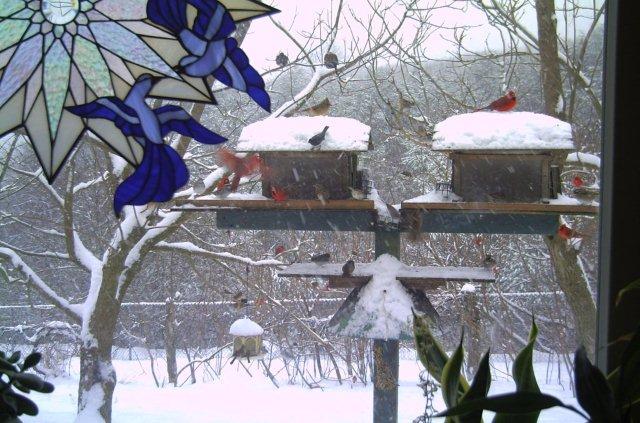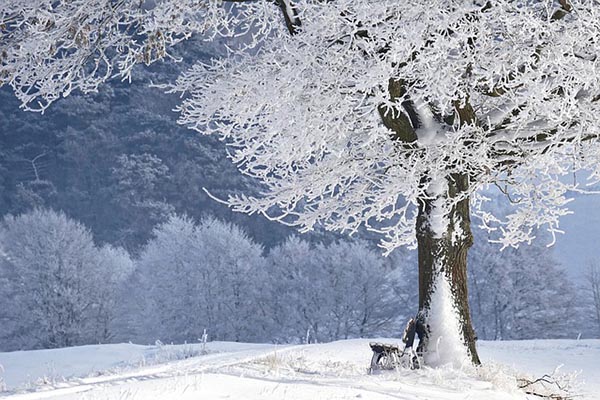On the Homestead: Birding
 Birding has remained the number one hobby in the United States for several years followed by gardening. Both go hand in hand as we must care for our wild birds and their habitat. I was sitting at the kitchen table in the breakfast nook clutching the Federal and State Income Tax forms with a blank stare of “I don’t care”. I put them away in the trash box (inadvertently of course) and took on a happy countenance by looking out over the snowy landscape at all the birds around the feeders.
Birding has remained the number one hobby in the United States for several years followed by gardening. Both go hand in hand as we must care for our wild birds and their habitat. I was sitting at the kitchen table in the breakfast nook clutching the Federal and State Income Tax forms with a blank stare of “I don’t care”. I put them away in the trash box (inadvertently of course) and took on a happy countenance by looking out over the snowy landscape at all the birds around the feeders.
I was trying to count the different varieties at the feeder and in the adjacent trees: Cardinals 15, Red Bellied Woodpecker 1, Downey Woodpecker 1, cowbird 1, Juncos beyond counting as they covered the ground, Blue jays a dozen at least, Doves over 22 now from the original pair twenty five or so years back, endless sparrows, house wrens, Tufted Titmice, Finches, and the occasional Red Wing Blackbird. Oh yes, we have one Mockingbird.
What is interesting to me is the Doves used to be a hunting sport years back but the young farm boys are now all old men and no time for such sport. Good!
I have not listed all as I do not keep records of the birds as Diane does but when I have a question of who is who, she helps me along in my quest for identification-dragging out her Audubon Eastern Birds edition I gave her as a 1st year anniversary gift some 36 or so years ago. Who keeps count?
Of course they are all not on the feeders at the same time, they seem to take turns, some going for the Millet seed, others for the Black oil seed. The peanut suet is the big hit and keeps the woodpeckers going in this cold winter.
The lead in picture is our big feeder and my musings take me into the realm of building a new improved model, one that holds more feed and some sort of lip at the bottom so the doves do not scoop it out to fall so much on the ground.
Of course what goes on the ground is taken up by the ground feeders who really do not like raised feeders. Then there are the clinging birds too all requiring a different food and a different favorite suet block. Peanut suet is the combined favorite and other investments in suet flavors are for naught-picky birds.
The Red Bellied Woodpeckers are the most interesting to me as they fly down on the back of the feeder where I can not see them and craftily reach around with their heads and grab a chunk of peanut suet. If I run out of suet in the morning they will fly up to our bedroom and tap-tap-tap. They know where we live and who is the benefactor. Tap-tap-tap. Maybe your woodpeckers are also demanding their due.
Once a month the crows swarm the feeders very early in the morning, usually at first light and clean it out. We note it is when there is little food available in the frozen whiteness this winter and we welcome them too. I suspect they, as many other birds just live on fat stored to survive and there is a high loss of birds this cold, bleak and white winter.
Crows are especially family oriented and roost in a communal. The first year fledglings as they mature and learn to gather food help in the next generation of baby birds. If I could have a pet crow I would surely be tempted as they make wonderful pets. But being a wild bird they are illegal to have. Then again why are wild parrots legal to have as pets? We have two Oak tree roosts that I can see and hear for crows and when the hawks appear as yesterday they set up a ruckus.
Hawks hunt in a pattern with crows where one swoops in and the giant roost oak tree shakes as the hundreds of crows take off after the solitary hawk. With their defenses down, the other hawk swoops in and speeds up to 240MPH and picks off a nestling. I did see once a hawk swoop down through our trees intertwined with branches, adroitly avoiding in flight any contact to pick off a bird at our feeder. Marvelous flyers.
We once saw an eagle. That was a rare sight and a magnificent bird.
Birds, if you look at their beaks indicated whether they are seedeaters, insect eaters or somewhere in-between. All of these birds are beneficial to the Gardner as they clean up thistle, seeds and insects. Some really specialize such as Black Capped Chickadees who want thistle. The thistle you buy comes from India and is sterilized. That means it is dried out and not very nutritious in your thistles feeder. So use only fresh dated stock and just throw away the old thistle seed, as they will not eat it. Thistle feeders are tubes with perches and eat ports down the sides. They need be hung in dry places such as under an eve.
We have found that the economy bags of wild birdseed contain a lot of sorghum seed that is ignored by all of our wild birds. It is cheaper for you and more beneficial to purchase a quality bird food such as the Pennington brand sold through many fine stores. We buy tons at Wal*Mart stores.
The same goes for Black Oil seed, a variety of oily sunflower that the Cardinals and Blue Jays will consume in vast quantities. Pennington ™ Black Oil Sunflower seeds when poured in a can and compared with other brands looks the best grade.
Storing birdseed I have found is best done in metal trashcans to keep the raccoons and possums out. These creatures of the night will pull lids off. So I have used bungee cords and they have teeth to chew through the cords.
I finally came up wit the ultimate storage container without buying “Bear Proof” cans. I purchase a metal trashcan (they will chew holes in the plastic cans), and then I turn the cans upside down and paint them with automotive gray primer. Reasoning is simple; they will rust and are not as durable as they were 20 years back. The advertised galvanizing is just a zinc coating and not the old time lead-zinc that lasted. Next I paint the bottom 1/3 of the cans with an automotive rubber type undercoat good and thick to avoid bottom water rusting. After all this is dry I take my drill and some small metal hooks with screw holes and sheet metal screw the hook to the top of the can area below the lid line. I use two hooks opposite the handles. Now I have four hook-up points for bungies or what ever works to keep the lids on. These raccoons, I call “Big Mama” can bend up one side and you need the support of 4 points.
Raccoons and Opossums are omnivorous and will eat most everything including whatever is in your trashcans. Use the bird technique of 4-point lid holders. It illegal to feed these creatures of the night but being soft you probably will. Try to feed them away from the house in a select spot so they know where to go. They will usually make their rounds on wet rainy nights. I had a family living in my barn for about three years that became somewhat tame, seeing me about in the day and doing them no harm. You do not want to pet wild animals. They bite and can carry many diseases.
Another problem with the wild raccoons: they poop. They make a mess in selected places for toilets in the barn.
We use 5 cans. The 32-gallon size holds 150 lbs of seeds. One can is for Black Oil; another for Thistle, although I am using a smaller can right now as that is not a volume feed. The remainders are for mixed seed. The suet we keep in the house.
If you have the space you can plant fruit berry trees for the birds near the house and this is a treat. The best tree is the White Mulberry that they love. You can get a Black Mulberry but the side of your house will be marked with purple stains if you do. Check your recent seed catalogs for these trees. Also chickens are crazy for mulberry fruits and they can be made into pies and goodies. Sweetening from the honeybees hive is necessary of course.
There is an excellent selection of bird feeders you can buy along with birdhouses and feeders as well as suet cakes for .99 cents each at Tractor Supply Company. The birds need food now to make eggs and raise more birds for our gardens and the balance of nature. You can find lots of birdhouse ideas on line or maybe you can find my favorite winter project book: Making Birdhouses and Feeders by Charles R. Self, Sterling Publishing Company, New York, NY. Go to http://www.amazon.com/ for books, they have good prices. If you do not have tools there is always some old man in the neighborhood that has a workshop and would love to have your company who will show you how to use tools.
Lastly, there is a famous catalog of birding supplies, albeit expensive, but beautiful: www.duncraft.com
Another social is birding clubs in your area. If you are a budding video movie producer like me just think of the fun and adventures you can share with a birding club, church group and even an elementary school class. Maybe this will open you up to new a National Geographic Photographer career.
Even the smallest feeder will attract birds and brings hours of enjoyment. This is especially great for shut-ins, and especially the elderly who are housebound.
God Bless.
Old Timer
Copyright: 2010, Back2theLand.Com, Mark Steel



